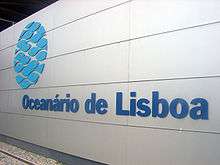Lisbon Oceanarium
The Lisbon Oceanarium (Portuguese: Oceanário de Lisboa, pronounced [osi.ɐˈnaɾi.u ðɨ liʒˈbo.ɐ]) is an oceanarium in Lisbon, Portugal. It is located in the Parque das Nações, which was the exhibition grounds for the Expo '98. It is the largest indoor aquarium in Europe.[4]
 The Oceanarium in the Parque das Nações | |
| Date opened | 1998[1] |
|---|---|
| Location | Lisbon, Portugal |
| Coordinates | 38.7635°N 9.0937°W |
| No. of animals | 16,000[2] |
| No. of species | 450[2] |
| Volume of largest tank | 5,000 m3 (180,000 cu ft)[3] |
| Annual visitors | 1,000,000[1] |
| Public transit access | |
| Website | www |
Architecture
The Lisbon Oceanarium’s conceptual design, architecture, and exhibit design was led by Peter Chermayeff of Peter Chermayeff LLC while at Cambridge Seven Associates. It is said to resemble an aircraft carrier, and is built on a pier in an artificial lagoon. Chermayeff is also the designer of the Osaka Oceanarium, one of the world's largest aquariums, and many other aquariums around the world.[5]
Exhibits

The Lisbon Oceanarium has a large collection of marine species — penguins, seagulls and other birds; sea otters (mammals); sharks, rays, chimaeras, seahorses and other bony fish; crustaceans; starfish, sea urchins and other echinoderms; sea anemones, corals and other cnidaria; octopuses, cuttlefish, sea snails and other mollusks; amphibians; jellyfish; marine plants and terrestrial plants and other marine organisms totaling about 16,000 individuals of 450 species.[2][6]
The main exhibit is a 1,000 m2 (11,000 sq ft), 5,000,000 l (1,300,000 US gal) tank with four large 49 m2 (530 sq ft) acrylic windows on its sides, and smaller focus windows strategically located around it to make sure it is a constant component throughout the exhibit space. It is 7 m (23 ft) deep, which allows pelagic swimmers to swim above the bottom dwellers, and provides the illusion of the open ocean. About 100 species from around the world are kept in this tank,[3] including sharks, rays, barracudas, groupers, and moray eels. One of the main attractions is a large sunfish.[7]
.jpg)
Four tanks around the large central tank house four different habitats with their native flora and fauna: the North Atlantic rocky coast, the Antarctic coastal line, the Temperate Pacific kelp forests, and the Tropical Indian coral reefs. These tanks are separated from the central tank only by large sheets of acrylic to provide the illusion of a single large tank. Throughout the first floor there are an additional 25 thematic aquariums with each of the habitats' own characteristics.[8]
The Lisbon Oceanarium is one of the few aquariums in the world to house a sunfish, because of their unique and demanding requirements for care. Other interesting species include two large spider crabs and two sea otters named Eusébio after the soccer player and Amália, named after the fado singer Amália Rodrigues. Unfortunately, both these others died and now the new two others are called Micas and Maré.
Notes
- "Who We Are". oceanario.pt. Oceanario de Lisboa. Retrieved 25 April 2010.
- Carvalho, Isa. "The beauty of the marine life". accessibleportugal.com. Accessible Portugal Online Magazine. Archived from the original on 20 April 2010. Retrieved 25 April 2010.
- "The Global Ocean". oceanario.pt. Oceanario de Lisboa. Retrieved 25 April 2010.
- "Biggest in Europe". Retrieved 24 August 2012.
- "Lisbon Oceanarium". peterchermayeff.com. Peter Chermayeff, LLC. Archived from the original on 27 April 2012. Retrieved 25 April 2010.
- "Oceanário de Lisboa". Retrieved 21 September 2013.
- "Global Ocean". oceanario.pt. Oceanario de Lisboa. Retrieved 25 April 2010.
- "Virtual Tour". oceanario.pt. Oceanario de Lisboa. Retrieved 25 April 2010.
External links

- Official website
- Photos from Ocenarium